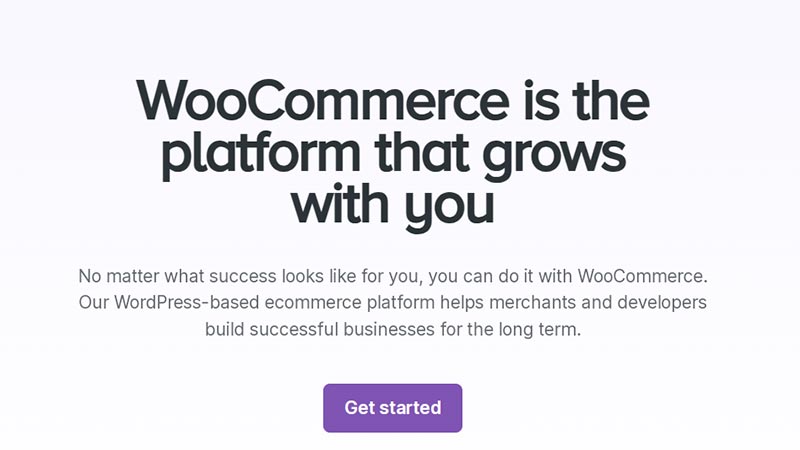Are you considering the development of an online store but struggling to select the most suitable platform? Shopify and WooCommerce are two of the top contenders in this regard. If you find yourself torn between the two, you have come to the right place. We are here to assist you in discerning the distinctions between these platforms.
While both Shopify and WooCommerce are robust e-commerce solutions, they vary in certain aspects. As a business owner, it is crucial to assess your specific needs and requirements, as well as explore the most effective methods to optimize your site for increased conversion rates.
This will help you determine which platform is the best fit for your business. Let’s delve into the features and benefits that each platform offers.
Shopify: An Overview

Shopify is a comprehensive e-commerce platform that operates on a monthly subscription basis. It provides users with a front-end online store and a robust admin panel for managing products, orders, customers, and other essential aspects of their business. Shopify allows for visual customization through themes and additional functionality via apps, making it an ideal choice for entrepreneurs and small businesses seeking a straightforward yet scalable solution.
Now that you have a clear understanding of what Shopify offers and how it can benefit your business, it is important to consider the platform’s pros and cons. Evaluating these factors will help you make an informed decision on whether Shopify is the right choice for your e-commerce needs.
Pros of Using Shopify
In the following section, we will delve into the numerous benefits that accompany the utilization of Shopify.
Ease of Use and Set Up
One of the key benefits of using Shopify is its user-friendly setup process. Establishing an online store is effortless – all it takes is signing up for an account and choosing a design template. With Shopify’s intuitive drag-and-drop interface, users can easily personalize pages and sections without the need for any coding expertise.
Furthermore, Shopify takes care of all the technical details such as hosting, security, and maintenance, allowing merchants to concentrate on expanding their business. Unlike the lengthy timeframe required to construct a custom site, setting up a Shopify store can be completed in just a few hours. This streamlined process enables merchants to quickly establish their online presence and start selling their products or services.
Robust Features and Functionalities
In addition to its fundamental e-commerce capabilities, Shopify provides a diverse array of robust features tailored to meet the requirements of small and medium-sized businesses. These features encompass multi-channel selling, inventory management, reporting and analytics, payment processing, abandoned cart recovery, SEO tools, and more.
Moreover, additional functions such as email marketing, online booking, and loyalty programs can be seamlessly integrated through the extensive app marketplace. Shopify consistently enhances its feature set through regular updates, ensuring that merchants remain at the forefront of e-commerce technology.
Mobile Optimization
As consumer shopping habits continue to evolve, the importance of optimized mobile experiences is on the rise. Shopify stands out in this regard by providing seamless responsiveness across all devices and screen sizes right from the start.
The platform offers the flexibility to create fully customized mobile sites or responsive themes. Additionally, dedicated iOS and Android apps enable tasks such as order fulfillment from anywhere, ensuring that merchants do not miss out on sales opportunities from mobile shoppers.
Flexible Plan Options
Shopify offers a range of subscription-based pricing plans starting at just $29 per month to accommodate a variety of business needs and budgets. The Basic, Shopify, and Advanced plans are tailored to meet different requirements in terms of features, storage, transaction limits, and more.
Furthermore, Shopify provides users with flexible tools to easily increase storage and transaction volume limits as needed through the backend. Customers have the option to choose between monthly and yearly billing cycles, with the latter offering substantial discounts for prepaying annually.
App and Partner Ecosystem
The Shopify app store stands out as one of the largest and most comprehensive among e-commerce platforms, offering over 3000 apps for merchants to enrich their online stores. These pre-built and regularly updated premium and free apps provide functionality such as accounting, shipping, and POS, making it easy for merchants to customize their online stores to meet their specific needs.
In addition to the wide range of apps available, Shopify boasts over 250 integration partners, including industry giants like Facebook, Snapchat, and Google. These partnerships enable seamless synchronization between Shopify and other platforms, allowing merchants to expand their business without the need to develop custom solutions from scratch.
Overall, the Shopify app store offers a wealth of options for merchants looking to improve their online stores and streamline their operations. With a vast selection of apps and integration partners, Shopify provides a robust platform for e-commerce businesses to thrive and grow.
Reliable and Robust
Shopify powers over one million stores worldwide and processes billions of dollars in sales annually. The platform undergoes rigorous security audits and testing to guarantee maximum uptime and data protection. Its numerous servers are strategically located across multiple geographic regions to provide redundancy.
Dedicated support is accessible 24/7 via phone and email. Shopify’s proven track record of reliability helps merchants avoid revenue losses during website outages or attacks on self-hosted sites.
Cons of Using Shopify
In this section, we will delve into the drawbacks associated with utilizing Shopify as a platform.
Limited Customizability
Although Shopify offers a variety of designs, templates, and themes, the level of customization available is somewhat limited compared to other platforms that allow you to build your own website. The layouts and sections can only be arranged in specific ways without the use of advanced coding.
To incorporate unique design elements or integrated features, it may be necessary to hire an expert developer, which can result in additional time and cost. This limitation could be a disadvantage for businesses with highly customized store concepts.
Less Control over Functionality
Outsourcing server management and upgrades can result in merchants relinquishing control over the technical and functional aspects of their stores. Critical changes are contingent upon Shopify’s roadmap and release schedule, leading to potential delays.
This lack of flexibility may pose a challenge for dynamic businesses that need to make immediate modifications in response to real-time demands.
Limited Data Export
Although the reports and analytics on Shopify are comprehensive, the ability to export purchasing behaviors, transactional records, and product data in bulk formats is limited and incomplete.
This lack of flexibility can make it difficult to migrate to other platforms without access to raw data. This lock-in factor may pose a challenge for large enterprises looking to transition to their own hosted solutions in the future.
Integration Challenges
Third-party extensions can sometimes be problematic due to potential conflicts, bugs, or compatibility issues with core updates. Additionally, heavy customization layers can hinder the ability to fully utilize new Shopify features.
Although there is a wide range of extensions available, certain niche requirements may not have dedicated apps, which can necessitate workaround coding. Furthermore, the process of fully migrating pre-existing content and functions can be complex.
It is important to carefully consider these factors when incorporating third-party extensions into your Shopify store to ensure a seamless and efficient operation.
WooCommerce: An Overview

WooCommerce is an open-source e-commerce plugin designed for WordPress, offering a customizable and flexible platform for online businesses. Unlike Shopify, which is a standalone platform, WooCommerce requires hosting and managing a self-hosted WordPress site.
While WooCommerce is free to use, there may be associated costs for additional plugins, themes, and developer support. This platform provides more flexibility but also has a steeper learning curve compared to Shopify. WooCommerce caters to a wide range of businesses, from small startups to large enterprises.
Let’s now explore the pros and cons of the WooCommerce platform to help you make an informed decision for your e-commerce needs.
Pros of Using WooCommerce
Here are some of the exciting advantages that come with each platform.
Open Source and Free
As an open-source platform, WooCommerce is available for free download and use, without any licensing fees. Merchants are not obligated to pay ongoing subscription costs and retain full ownership of their store data.
This cost-effective solution is ideal for small businesses, offering a more affordable option compared to paid alternatives. Additionally, WooCommerce’s open architecture enables extensive customizations through modifications and plugins, providing flexibility and scalability for businesses of all sizes.
Compatibility with WordPress
WooCommerce utilizes the strong foundation of the WordPress ecosystem. As the leading CMS, WordPress boasts extensive third-party support and one of the largest online communities available for assistance.
The compatibility of WooCommerce enables merchants to establish comprehensive online presences by combining blogging, marketing, and e-commerce within a single platform. This integration offers additional advantages through seamless connections between front-end and back-end functionalities.
Extensive Features Included
Although WooCommerce is a free platform, it provides a comprehensive range of essential e-commerce features such as product catalogs, shopping carts, tax calculations, inventory management, customer accounts, and reporting capabilities right from the start.
Furthermore, additional functionalities like subscription services, product add-ons, bulk stock management, cross-selling, and upselling can be easily added through affordable plugins. This level of feature parity with paid e-commerce solutions offers exceptional value without any subscription fees.
Mobile Responsiveness
WooCommerce offers a wide selection of visually appealing themes that are optimized for a seamless shopping experience on all mobile devices and screen sizes. Key features such as product filtering, zoom functionality, and quick checkout are fully compatible with mobile devices.
In addition, WooCommerce provides free iOS and Android apps that enable store owners to manage tasks such as orders, inventory, and reporting even when offline. This ensures that missed conversions are minimized and allows for greater flexibility in managing an online store on the go.
Customizable Designs
Built on a Content Management System (CMS), WooCommerce provides store owners with complete design control through various themes. This allows for easy customization of color schemes, layouts, and page sections without any difficulties. For more advanced customizations, options include using snippets, Child Themes, or making direct modifications in the code.
Furthermore, top-selling theme marketplaces offer a wide selection of professionally designed themes that cater to any industry or brand, ensuring that your online store stands out and attracts customers.
Robust Security
WooCommerce, which powers over 30% of online stores, is subject to rigorous testing and upgrades by developers. Its infrastructure and development practices are designed to meet the highest security standards, including SSL encryption, brute force protection, and input sanitization.
Regular vulnerability patches are implemented to safeguard data against potential attacks. Additionally, backups, caching, and CDNs are utilized to enhance site speed and ensure uptime, even during periods of heavy traffic.
Cons of Using WooCommerce
Below, we will examine some of the drawbacks associated with this platform.
Steep Learning Curve
While WooCommerce is an open-source platform, it comes with a trade-off of complexity. Configuring integrations, themes, and plugins requires a strong technical skill set and a significant time investment to comprehend codebases and documentation.
Navigating both free and paid support forums can be challenging due to their steep learning curves. This initial difficulty may be frustrating, particularly for entrepreneurs who do not have a technical background.
Heavy Resource Usage
Because of its extensibility and customizability, heavily modified WooCommerce sites with numerous plugins often require a significant amount of server resources.
Sites with large product catalogs, intricate designs, or poorly optimized code can experience slow performance or downtime when hosted on inadequate servers. It may be necessary to make initial investments to upgrade infrastructure and accommodate future growth.
Incompatibility Issues
The WooCommerce plugin ecosystem lacks consistent quality control, leading to potential conflicts and incompatibilities between themes, plugins, and core updates that can disrupt functionality or introduce bugs without warning.
Addressing and resolving such issues often demands significant developer time and the testing of various module combinations. Hastily released third-party updates may also jeopardize the stability of a website.
The over-reliance on numerous plugins can accumulate technical debt over time, resulting in fragmented functionality scattered across multiple third-party codebases. This can complicate long-term support, migrations, and custom work, as core feature integrations may be subpar and necessitate custom solutions.
As a result, future-proofing a website becomes increasingly challenging, particularly when plugin developers cease providing support.
Limited Built-in Features
Although WooCommerce provides a solid foundation, its standard offering lacks some advanced functionalities found in premium platforms. Specialized capabilities such as multi-vendor marketplaces, product bundling, and loyalty programs require complete reliance on external extensions.
Detailed Comparison: Shopify or WooCommerce

Now, let us delve into the key decision factors in detail.
Key Features
Both Shopify and WooCommerce are robust e-commerce platforms that offer core functionality, apps, and theme libraries to help businesses create and manage online stores. However, their approaches to these aspects differ significantly.
Shopify provides a complete turnkey solution that prioritizes ease of use. It includes essential tools such as a product catalog, shopping cart, payment processing, shipping options, and tax calculations right out of the box. Customization is made easy through the Shopify App Store, which offers thousands of supplemental apps. Additionally, Shopify takes care of hosting and managing the store infrastructure, database, and updates.
On the other hand, WooCommerce is a plugin for WordPress that offers core features like product management, cart functionality, and checkout processes. Additional functionality is achieved through a vast library of third-party plugins that require manual installation and updates. Unlike Shopify, WooCommerce merchants are responsible for self-hosting and managing their infrastructure using a web host.
While WooCommerce offers more technical flexibility, it requires a certain level of configuration knowledge and ongoing server maintenance that may be challenging for some merchants. One advantage of WooCommerce is its low barrier to entry, as it is free compared to Shopify’s subscription fees. However, the total cost of ownership, including hosting expenses, can eventually rival Shopify’s pricing for larger stores.
In conclusion, both Shopify and WooCommerce have their strengths and weaknesses, and the choice between the two ultimately depends on the specific needs and technical capabilities of the business.
Ease of Use
Establishing an online store is made effortless and efficient through Shopify’s user-friendly drag-and-drop interface, which can be accessed through any web browser. Merchants simply need to register, personalize their storefront themes visually, and add products without the need for coding. The dashboard navigation and admin screens are both intuitively designed for individuals who may not have technical expertise.
In contrast, setting up WooCommerce requires basic WordPress skills in addition to drag-and-drop capabilities. Merchants must install and configure the plugin, choose a theme that is compatible with WooCommerce, and have an understanding of their web hosting control panel for tasks such as installing SSL. More complex customizations often necessitate collaboration with developers, unlike Shopify’s no-code approach.
When transitioning between themes on Shopify, the store remains unaffected as templates are inherently compatible. Conversely, changing themes on WooCommerce may result in functionality issues that require developer assistance. Overall, for businesses in search of a hassle-free, plug-and-play solution, Shopify offers a superior level of user-friendliness.
Costs
Shopify offers transparent pricing with monthly or annual subscription fees ranging from $29 to $299, depending on the plan required. Each plan includes all features without any hidden fees. In addition to the subscription fees, there are transaction and payment gateway charges to consider.
The fees associated with Shopify are reasonable for the comprehensive managed platform it provides, saving time and resources for merchants. Larger businesses can take advantage of Shopify’s discount plans to reduce per-transaction costs as their sales volumes increase.
On the other hand, setting up and maintaining a WooCommerce store involves various additional costs to consider:
- Web hosting fees typically range from $10 to $50 per month, depending on the storage, bandwidth, and features required to handle store traffic. Reliable hosting is essential for optimal performance and uptime.
- The cost of obtaining an SSL certificate for secure checkout is approximately $100 per year, crucial for establishing trust with customers during the checkout process.
- Purchasing necessary plugins to enable functionalities such as payments, shipping, etc., can range from $50 to $150 per plugin.
- Potential charges for developer support may arise for complex themes, customizations, or migration/upgrades.
- Backup solutions for securely storing store and customer data are recommended, with costs ranging from $5 to $15 per month.
While WooCommerce itself is free to use, when factoring in all overhead costs, the total expenses can easily exceed Shopify’s subscription fees, especially for high-traffic stores. It is essential to carefully estimate the total cost of ownership to avoid unexpected expenses.
Extensions and Apps
The Shopify App Store boasts over 4000 optional apps, providing merchants with unparalleled flexibility to tailor their storefront to meet evolving needs. These pre-built apps, developed by Shopify’s global network of developers, allow functionality to be easily added on demand.
Merchants can sweeten their online stores with features such as shipping carriers, abandoned cart recovery, loyalty programs, and inventory management, seamlessly integrating into the core Shopify admin. Developers receive 60% of app revenue as incentives for their contributions.
In comparison, WooCommerce plugins exceed 10,000, sourced from various third-party developers on WordPress.org. This vast selection can be overwhelming for non-technical merchants, as it requires careful consideration of compatibility, developer support, and potential bugs. Shopify simplifies this process by offering curated solutions that cater to different businesses without the need for coding skills or ongoing support.
While plugins offer extensive customization options, Shopify apps provide tailored solutions without the complexities associated with plugins. Despite this, some advanced plugins may be more cost-effective than specialized Shopify apps for larger stores.
Performance
Shopify boasts faster load times due to its globally optimized infrastructure tailored for E-commerce workloads. This allows merchants to focus on expanding their business without the need to concern themselves with hardware upgrades, caching, or advanced optimizations for quicker store performance.
In contrast, WooCommerce’s performance is contingent upon the hosting chosen by merchants and how it is configured. Opting for cheaper hosts may result in difficulties handling heavy traffic and order volumes. Additionally, the use of complex themes or poorly integrated plugins could potentially hinder download speeds. Merchants must diligently monitor their site speeds and take proactive measures to optimize hosting, databases, caching, and more to ensure a seamless shopping experience for buyers.
To achieve enhanced performance akin to Shopify, merchants can either possess ongoing technical skills or utilize a service such as Bluehost, which offers managed WooCommerce hosting. Failure to address slow-loading pages can significantly impact conversion rates. Shopify alleviates these concerns for those seeking a more hands-off approach to website optimization.
Developer Capabilities
While Shopify offers a wide range of functionalities, implementing unique workflow customizations that are not supported by existing apps may necessitate reaching out to developer partners. Their system imposes limitations on what can be modified for security and stability purposes.
On the other hand, WooCommerce grants users full access to code files and databases for more advanced modifications. Its ecosystem has evolved organically, resulting in plugins and themes that may occasionally present edge cases or bugs requiring adjustments.
Developers proficient in PHP and MySQL can leverage this access to exercise greater control over the functionality of their stores, eliminating the need for a third-party platform like Shopify. This enables the execution of complex projects that surpass the constraints of Shopify.
Security and Compliance
Both platforms implement stringent security measures to protect their large user bases. Shopify stores operate within isolated sandboxes with restricted permissions, while WooCommerce installations share host resources, increasing the potential for security risks. Shopify takes care of security updates on behalf of merchants, minimizing the risk of technical vulnerabilities.
When it comes to compliance requirements such as GDPR and PCI, there are notable differences between the two platforms. Shopify manages most aspects of compliance transparently, whereas WooCommerce merchants may encounter challenges in installing necessary plugins and configurations themselves.
For businesses that cannot afford any downtime, Shopify offers superior reliability through its cutting-edge infrastructure, which is replicated across multiple data centers worldwide.
Scalability
As demand for products and services grows rapidly, Shopify seamlessly adjusts its infrastructure to accommodate the increasing orders and buyer traffic. This allows merchants to focus on their business operations without the need to worry about managing servers, cache layers, or technical scaling tasks. Shopify’s robust global architecture efficiently processes millions of transactions each month.
In contrast, WooCommerce hosted on standard servers may struggle to handle sudden spikes in traffic. Merchants are required to upgrade their hosting plans promptly, set up object caching, utilize a content delivery network (CDN), establish staging servers before launching, and test the website’s capacity to handle traffic – all tasks that Shopify manages effortlessly.
Advanced technical expertise is necessary to optimize WooCommerce stores for high transaction volumes; otherwise, slow loading speeds or downtime can negatively impact business performance, especially during critical seasonal periods.
Customizability
Shopify themes offer a limited range of design options compared to the vast array of choices available with self-hosted platforms. While there are thousands of prebuilt Shopify themes that allow for some customization of colors, fonts, and basic layouts, making more advanced visual changes may require the expertise of a Shopify developer or the selection of a more customizable theme.
On the other side, WooCommerce benefits from the robust design capabilities of WordPress, which powers a wide variety of professional e-commerce themes. By hiring WooCommerce Developers, you can create custom, pixel-perfect designs that bring any visual concept to life.
WooCommerce themes can be modified more freely than Shopify themes, allowing for greater flexibility while still maintaining core features and security updates consistently across all stores. This flexibility empowers businesses to establish unique brand identities that stand out in the competitive e-commerce landscape.
Learning Curve
Shopify simplifies web hosting, software installation, and coding for easy management by non-technical personnel. Entrepreneurs who are already familiar with WordPress will find it easier to pick up WooCommerce due to their existing knowledge.
For those who are new to e-commerce, Shopify offers a seamless onboarding process with zero learning curve. Detailed help files and support are readily available to address any common issues that may arise.
Both platforms are user-friendly once you become familiar with their interfaces, although there may be a slight learning curve at the beginning. Ultimately, Shopify stands out as the simplest option for new merchants.
Customer Support
Shopify offers round-the-clock support through phone, email, and live chat provided by their dedicated global teams. Response times typically average under an hour, even for complex issues, and are backed by strict Service Level Agreements (SLAs).
Nevertheless, the quality of WooCommerce support can vary depending on the hosting provider or theme/plugin developers involved. Common inquiries may take longer to resolve through community forums compared to Shopify’s centralized and prompt responses. Additionally, Shopify provides subscription credits as incentives for any store issues that exceed the committed timelines.
For businesses with mission-critical operations, Shopify’s premium and enterprise support packages offer direct access to engineers and personalized onboarding, a level of service that goes beyond what is typically available with WooCommerce.
Conclusion
In conclusion, here are some guidelines to help you choose the ideal platform for your business:
For new startups with limited budgets and non-tech founders, WooCommerce is a great option to start with. As your business grows and the costs can be justified, consider switching to Shopify for more advanced features.
For solopreneurs and small to medium-sized businesses, Shopify is the recommended choice from the beginning. It is easy to use and can scale with your business without requiring extensive maintenance, making it ideal for one-person operations.
It is important to choose the right platform for your business needs to ensure success.
Now over to you,
Which platform you are using to set up an online store – WooCommerce or Shopify?
Please follow us on Facebook and Twitter to show your support.
